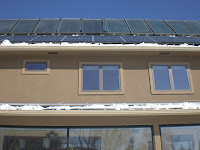TechnologyWind is a clean, inexhaustible, and renewable energy resource that holds the potential to provide huge amounts of power in the U.S. Wind energy is one of the fastest-growing forms of electricity generation in the world. According to the
National Renewable Energy Laboratory (NREL), the U.S. can currently generate more than 25,000 megawatts (MW) of electricity from the wind, which is enough to power about 7 million average American homes. Industry experts predict that, with proper development, wind energy could provide 20 percent of our country’s energy needs.
Wind turbines capture wind power, turning kinetic energy into mechanical power. Wind turns the large, scythe-like blades, which in turn spin a shaft inside the turbine that is connected to a generator that makes electricity. Small turbines can be used for individual homes or uses, while large turbines—the monolithic structures seen on wind farms—are more efficient and supply bulk energy needs for the grid.
Benefits of wind power include:
• Clean fuel source
• Turbines don’t produce emissions contributing to acid rain or greenhouse gasses
• Wind supply in U.S. is abundant
• Low price technology
• Economic benefits to land owners who rent their land for wind power farms
• Wind turbines don’t consume or require water
• Energy can be used in a variety of applications from individual sailboats to large-scale wind plants
The
Department of Energy (DOE) provides a comprehensive background on wind energy, as well as detailing the advantages and disadvantages of wind energy.
Local ScoopAlthough the potential for wind power is abundant in Colorado, electricity is primarily generated from fossil fuels, with over 83 percent produced from coal. Yet Colorado is increasingly looking to wind power in terms of wind farm development, cutting-edge research at NREL's National Wind Technology Center, and partnerships between private utility companies and progressive environmental nonprofits.
Colorado has an estimated 6 million acres of windy lands, particularly on the eastern plains. Two large-scale wind developments exist at Ponnequin Wind Farm near the Wyoming border, Cedar Creek Farm outside of Greeley, and the Peetz Table Wind Farm near Sterling.
If you’re curious about the Ponnequin wind farm you can read a little about it
here at the American Wind Energy Association website or have an aerial look on Google
maps.
Additionally,
Vestas Wind Systems of Denmark is currently building a turbine blade plant in Windsor, Colo., north of Denver. This will better accommodate the delivery of large turbine blades to wind farm sites in the western U.S.
NREL's National Wind Technology Center is preparing to install the two largest turbines ever tested at the laboratory in order to further increase turbine performance and technological efficiency. NREL also partnered with Wind Powering America to launch the
Wind for Schools project in 2005. A pilot project in Walsenburg, Colo. resulted in one small turbine powering the local school in conjuction with a wind energy curriculum. This project (link to PDF) is set to install small wind turbines at rural schools, replicating the Colorado pilot process in six Great Plains states (CO, ID, KS, MT, NE, SD).
Xcel Energy launched Windsource in 1998. The program gives Colorado consumers a chance to pay a premium to support the development of electricity generated by Colorado wind farms. About 47,000 customers enrolled, yet according to a recent
article in the Rocky Mountain News the utility company overcharged customers for the program and will refund them in the near future.
Xcel built Colorado's first commercial wind farm, Ponnequin Wind Farm, and also purchased the entire energy output of the state's second wind farm, Ridgecrest near Peetz. Xcel also uuses wind energy from the Colorado Green, Spring Canyons, Peetz Table, Logan Wind, Twin Buttes, and Cedar Creek wind farms.
Policy MechanismsSee
information on the American Wind Energy Association website on how President Obama's stimulus package will affect wind energy development. Wind power is capable of becoming a major contributor to America’s electricity supply over the next three decades, according to a report by the U.S. Department of Energy. The groundbreaking report, "20% Wind Energy by 2030: Increasing Wind Energy’s Contribution to U.S. Electricity Supply," looks closely at one scenario for reaching 20 percent wind energy by 2030 and contrasts it to a scenario of no new U.S. wind power capacity. The AWEA
explains the report in light of a new energy agenda prompted by the Obama administration.
There are many significant provisions to benefit renewable energy in the economic recovery legislation passed by Congress and signed into law by President Obama on February 17, 2009, including:
* a Treasury Department grant program for renewable energy developers,
* a long-term extension of the wind energy production tax credit,
* an Energy Department loan guarantee program for developers and manufacturers,
* an expansion of Energy Department research, development and deployment funding, and
* a tax credit for advanced energy manufacturers.
See the AWEA Summary of Provisions of Interest to the Wind Energy Industry (March 2009) and the AWEA Summary of Provisions of Interest to Small Wind Turbine Producers and Consumers (March 2009) for further information, as well as the AWEA web site. [FYI these are PDF files and will need links.]
GlossaryWondering what a yaw drive does? The Institute of Electrical and Electronics Engineers (IEEE) provides a comprehensive, web-based
glossary on any technical and general terms associated with wind power.
--Cassie




 photostream (Wood pellets are a form of biomass)
photostream (Wood pellets are a form of biomass)

